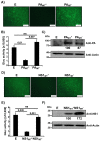Increasing the Safety Profile of the Master Donor Live Attenuated Influenza Vaccine
- PMID: 32013198
- PMCID: PMC7168643
- DOI: 10.3390/pathogens9020086
Increasing the Safety Profile of the Master Donor Live Attenuated Influenza Vaccine
Abstract
Seasonal influenza epidemics remain one of the largest public health burdens nowadays. The best and most effective strategy to date in preventing influenza infection is a worldwide vaccination campaign. Currently, two vaccines are available to the public for the treatment of influenza infection, the chemically Inactivated Influenza Vaccine (IIV) and the Live Attenuated Influenza Vaccine (LAIV). However, the LAIV is not recommended for parts of the population, such as children under the age of two, immunocompromised individuals, the elderly, and pregnant adults. In order to improve the safety of the LAIV and make it available to more of the population, we sought to further attenuate the LAIV. In this study, we demonstrate that the influenza A virus (IAV) master donor virus (MDV) A/Ann Arbor/6/60 H2N2 LAIV can inhibit host gene expression using both the PA-X and NS1 proteins. Furthermore, we show that by removing PA-X, we can limit the replication of the MDV LAIV in a mouse model, while maintaining full protective efficacy. This work demonstrates a broadly applicable strategy of tuning the amount of host antiviral responses induced by the IAV MDV for the development of newer and safer LAIVs. Moreover, our results also demonstrate, for the first time, the feasibility of genetically manipulating the backbone of the IAV MDV to improve the efficacy of the current IAV LAIV.
Keywords: immunogenicity; influenza; live attenuated influenza vaccine; master donor virus; protection efficacy; vaccine safety; virus–host interaction.
Conflict of interest statement
The authors declare no conflict of interest.
Figures







Similar articles
-
Mutation L319Q in the PB1 Polymerase Subunit Improves Attenuation of a Candidate Live-Attenuated Influenza A Virus Vaccine.Microbiol Spectr. 2022 Jun 29;10(3):e0007822. doi: 10.1128/spectrum.00078-22. Epub 2022 May 18. Microbiol Spectr. 2022. PMID: 35583364 Free PMC article.
-
A Live Attenuated Influenza Vaccine Elicits Enhanced Heterologous Protection When the Internal Genes of the Vaccine Are Matched to Those of the Challenge Virus.J Virol. 2020 Jan 31;94(4):e01065-19. doi: 10.1128/JVI.01065-19. Print 2020 Jan 31. J Virol. 2020. PMID: 31748399 Free PMC article.
-
Generation of DelNS1 Influenza Viruses: a Strategy for Optimizing Live Attenuated Influenza Vaccines.mBio. 2019 Sep 17;10(5):e02180-19. doi: 10.1128/mBio.02180-19. mBio. 2019. PMID: 31530680 Free PMC article.
-
Modulation of Innate Immune Responses by the Influenza A NS1 and PA-X Proteins.Viruses. 2018 Dec 12;10(12):708. doi: 10.3390/v10120708. Viruses. 2018. PMID: 30545063 Free PMC article. Review.
-
Seasonal influenza vaccines.Curr Top Microbiol Immunol. 2009;333:43-82. doi: 10.1007/978-3-540-92165-3_3. Curr Top Microbiol Immunol. 2009. PMID: 19768400 Review.
Cited by
-
Influenza Virus and Vaccination.Pathogens. 2020 Mar 17;9(3):220. doi: 10.3390/pathogens9030220. Pathogens. 2020. PMID: 32192196 Free PMC article.
-
Natural Selection of H5N1 Avian Influenza A Viruses with Increased PA-X and NS1 Shutoff Activity.Viruses. 2021 Sep 3;13(9):1760. doi: 10.3390/v13091760. Viruses. 2021. PMID: 34578340 Free PMC article.
-
NS1 and PA-X of H1N1/09 influenza virus act in a concerted manner to manipulate the innate immune response of porcine respiratory epithelial cells.Front Cell Infect Microbiol. 2023 Jul 26;13:1222805. doi: 10.3389/fcimb.2023.1222805. eCollection 2023. Front Cell Infect Microbiol. 2023. PMID: 37565063 Free PMC article.
-
Could live attenuated vaccines better control COVID-19?Vaccine. 2021 Sep 15;39(39):5719-5726. doi: 10.1016/j.vaccine.2021.08.018. Epub 2021 Aug 11. Vaccine. 2021. PMID: 34426024 Free PMC article. Review.
-
Optimizing the Live Attenuated Influenza A Vaccine Backbone for High-Risk Patient Groups.J Virol. 2022 Oct 26;96(20):e0087122. doi: 10.1128/jvi.00871-22. Epub 2022 Oct 3. J Virol. 2022. PMID: 36190240 Free PMC article.
References
-
- Shaw M.L., Palese P. Othomyxovirdae: the viruses and their replication. Lippincott Williams and Wilkins; Philadelphia, PA, USA: 2007.
-
- Iuliano A.D., Roguski K.M., Chang H.H., Muscatello D.J., Palekar R., Tempia S., Cohen C., Gran J.M., Schanzer D., Cowling B.J., et al. Estimates of global seasonal influenza-associated respiratory mortality: A modelling study. Lancet. 2018;391:1285–1300. doi: 10.1016/S0140-6736(17)33293-2. - DOI - PMC - PubMed
-
- Flannery B., Chung J.R., Belongia E.A., McLean H.Q., Gaglani M., Murthy K., Zimmerman R.K., Nowalk M.P., Jackson M.L., Jackson L.A., et al. Interim Estimates of 2017-18 Seasonal Influenza Vaccine Effectiveness—United States, February 2018. MMWR Morb. Mortal. Wkly. Rep. 2018;67:180–185. doi: 10.15585/mmwr.mm6706a2. - DOI - PMC - PubMed
Grants and funding
LinkOut - more resources
Full Text Sources

